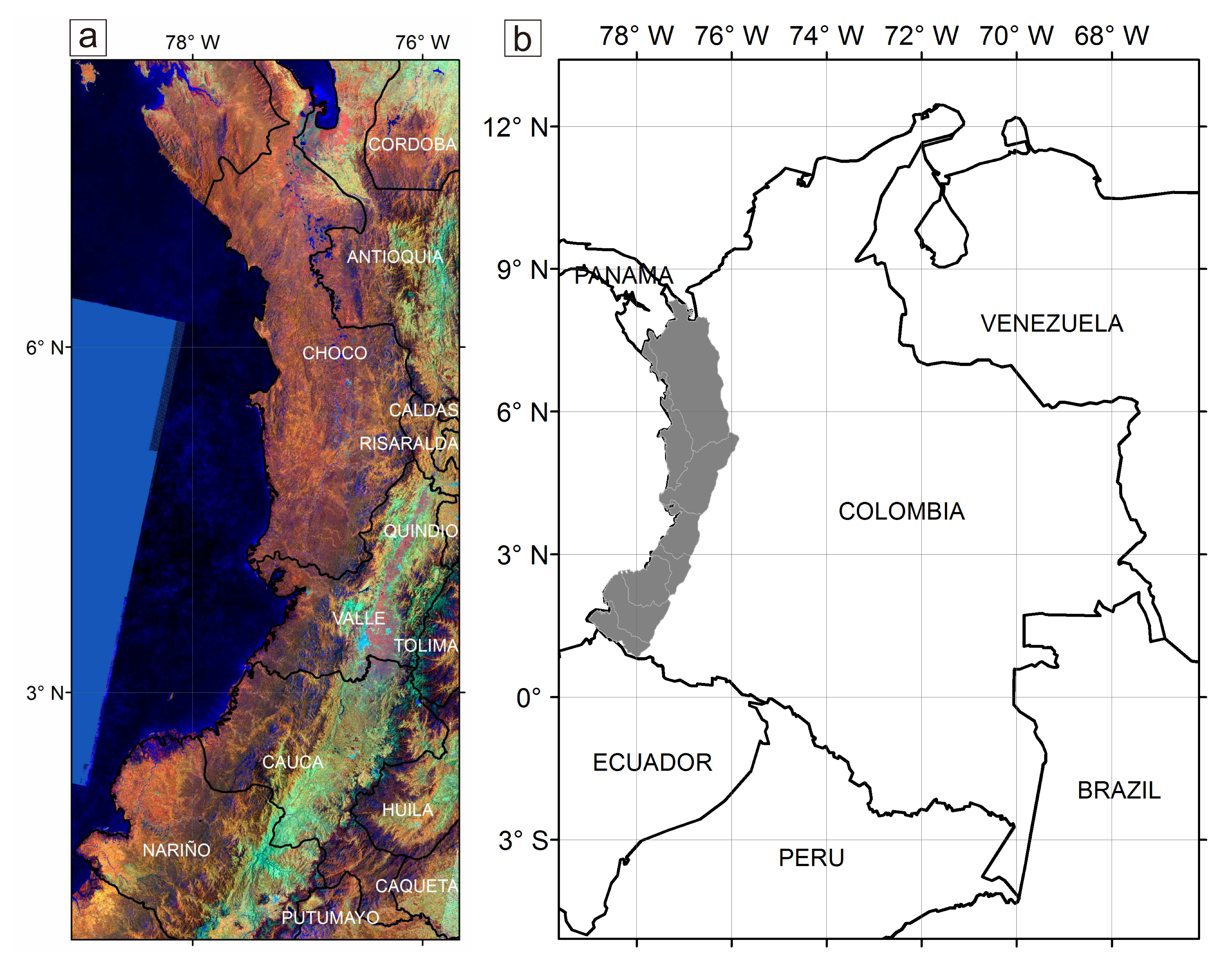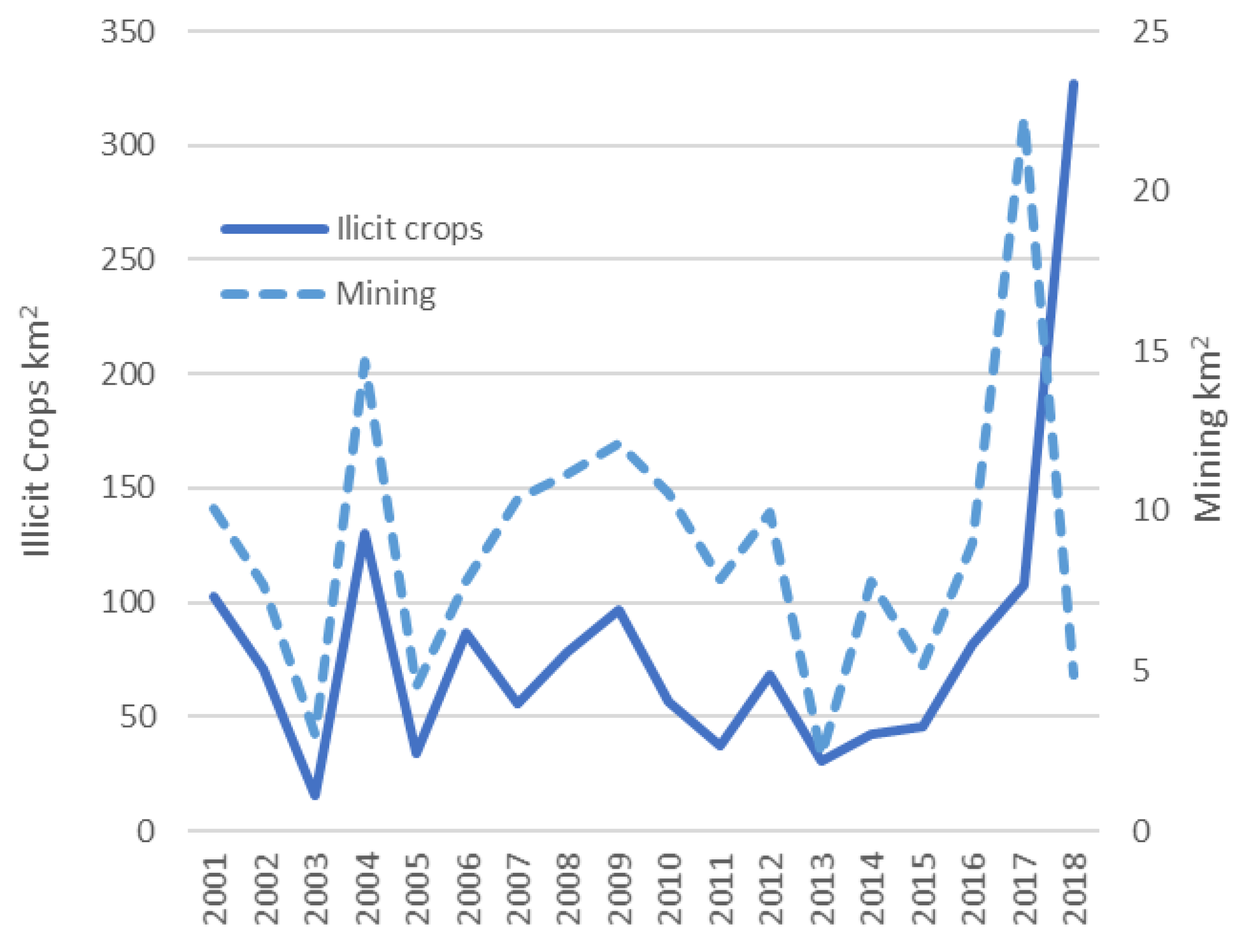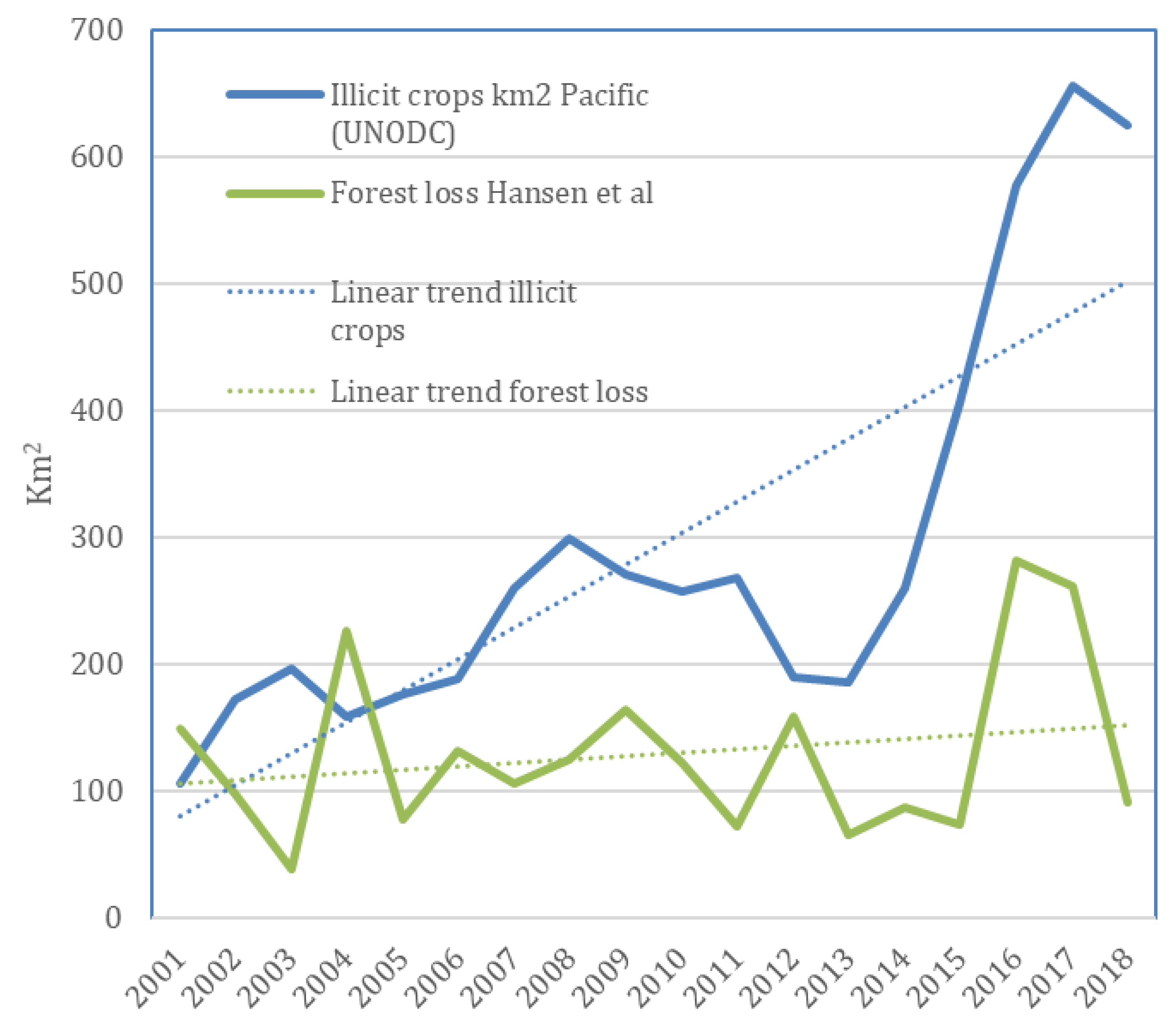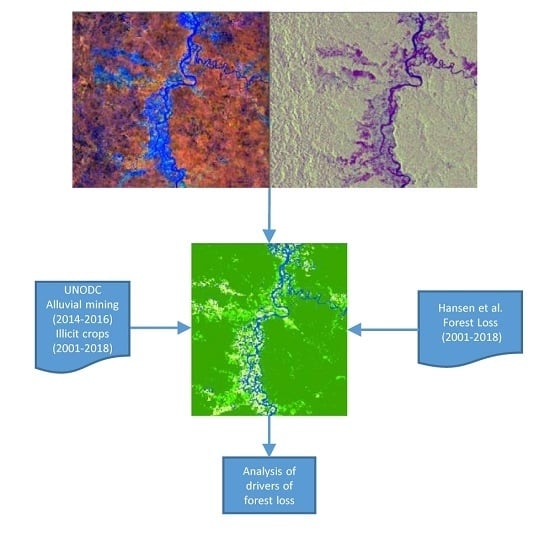Drivers of Forest Loss in a Megadiverse Hotspot on the Pacific Coast of Colombia
Abstract
1. Introduction
2. Materials and Methods
2.1. Study Area
2.2. Data and Pre-Processing
2.2.1. Analysis and Processing of Sentinel-1
2.2.2. Landsat 7-8 and Sentinel-2
2.2.3. Training and Validation Data
2.3. Classification and Accuracy Assessment
2.4. Ancillary Data
3. Results
4. Discussion
5. Conclusions
Author Contributions
Funding
Acknowledgments
Conflicts of Interest
Appendix A
References
- Dinerstein, E.; Olson, D.M.; Graham, D.L.; Webster, A.L.; Primm, S.A.; Bookbinder, M.P.; Ledec, G. A Conservation Assessment of the Terrestrial Ecoregions of Latin America and the Caribbean; The World Bank: Washington, DC, USA, 1995; p. 135. [Google Scholar]
- Myers, N.; Mittermeier, R.A.; Mittermeier, C.G.; Da Fonseca, G.A.B.; Kent, J. Biodiversity hotspots for conservation priorities. Nature 2000, 403, 853. [Google Scholar] [CrossRef] [PubMed]
- Watson, R.T.; Dixon, J.A.; Hamburg, S.P.; Janetos, A.C.; Moss, R.H. Protecting our planet, securing our future. In Linkages Among Global Environmental Issues and Human Heeds; UNEP; NASA; The World Bank: Washington, DC, USA, 1998; p. 95. [Google Scholar]
- Meyer, V.; Saatchi, S.; Ferraz, A.; Xu, L.; Duque, A.; García, M.; Chave, J. Forest degradation and biomass loss along the Chocó region of Colombia. Carbon Balance Manag. 2019, 14, 2. [Google Scholar] [CrossRef] [PubMed]
- Galeano, G.; Suárez, S.; Balslev, H. Vascular plant species count in a wet forest in the Chocó area on the Pacific coast of Colombia. Biodivers. Conserv. 1998, 7, 1563–1575. [Google Scholar] [CrossRef]
- Etter, A.; McAlpine, C.; Pullar, D.; Possingham, H. Modelling the conversion of Colombian lowland ecosystems since 1940: Drivers, patterns and rates. J. Environ. Manag. 2006, 79, 74–87. [Google Scholar] [CrossRef] [PubMed]
- Proença, V.; Pereira, H.M. Ecosystem Changes, Biodiversity Loss and Human Well-Being. In Reference Module in Earth Systems and Environmental Sciences; Elsevier: Amsterdam, The Netherlands, 2015. [Google Scholar] [CrossRef]
- Sierra, C.A.; Mahecha, M.; Poveda, G.; Álvarez-Dávila, E.; Gutierrez-Velez, V.H.; Reu, B.; Feilhauer, H.; Anáya, J.; Armenteras, D.; Benavides, A.M.; et al. Monitoring ecological change during rapid socio-economic and political transitions: Colombian ecosystems in the post-conflict era. Environ. Sci. Policy 2017, 76, 40–49. [Google Scholar] [CrossRef]
- Gill, M.; Jongman, R.H.G.; Luque, S.; Mora, B.; Paganini, M.; Szantoi, Z. A Sourcebook of Methods and Procedures for Monitoring Essential Biodiversity Variables in Tropical Forests with Remote Sensing; Land Cover Project Office: Edmonton, CA, USA, 2017. [Google Scholar]
- Álvarez, M.D. Environmental damage from illicit drug crops in Colombia. In Extreme Conflict and Tropical Forests; Jong, W.D., Donovan, D., Abe, K., Eds.; Springer: Dordrecht, The Netherlands, 2007; Volume 5. [Google Scholar]
- Landholm, D.M.; Pradhan, P.; Kropp, J.P. Diverging forest land use dynamics induced by armed conflict across the tropics. Glob. Environ. Chang. 2019, 56, 86–94. [Google Scholar] [CrossRef]
- Santos, J.M. Letter to Next Colombian President; Presidencia de la Republica: Bogota, Colombia, 2018.
- Armenteras, D.; Schneider, L.; Dávalos, L.M. Fires in protected areas reveal unforeseen costs of Colombian peace. Nature Ecol. Evol. 2019, 3, 20–23. [Google Scholar] [CrossRef]
- Rincón-Ruiz, A.; Correa, H.L.; León, D.O.; Williams, S. Coca cultivation and crop eradication in Colombia: The challenges of integrating rural reality into effective anti-drug policy. Int. J. Drug Policy 2016, 33, 56–65. [Google Scholar] [CrossRef]
- Clerici, N.; Armenteras, D.; Kareiva, P.; Botero, R.; Ramírez-Delgado, J.P.; Forero-Medina, G.; Ochoa, J.; Pedraza, C.; Schneider, L.; Lora, C.; et al. Deforestation in Colombian protected areas increased during post-conflict periods. Sci. Rep. 2020, 10, 4971. [Google Scholar] [CrossRef]
- Armenteras, D.; Cabrera, E.; Rodríguez, N.; Retana, J. National and regional determinants of tropical deforestation in Colombia. Reg. Environ. Change 2013, 13, 1181–1193. [Google Scholar] [CrossRef]
- Furumo, P.R.; Lambin, E.F. Scaling up zero-deforestation initiatives through public-private partnerships: A look inside post-conflict Colombia. Glob. Environ. Change 2020, 62, 102055. [Google Scholar] [CrossRef]
- Hansen, M.C.; Potapov, P.V.; Moore, R.; Hancher, M.; Turubanova, S.A.; Tyukavina, A.; Thau, D.; Stehman, S.V.; Goetz, S.J.; Loveland, T.R.; et al. High-Resolution Global Maps of 21st-Century Forest Cover Change. Science 2013, 342, 850–853. [Google Scholar] [CrossRef] [PubMed]
- Corlett, R.; Primark, R. Tropical Rain Forests: An Ecological and Biogeographical Comparison, 2nd ed.; Blackwell Publishing: Hoboken, NJ, USA, 2011. [Google Scholar]
- Palomino-Ángel, S.; Anaya-Acevedo, J.A.; Botero, B.A. Evaluation of 3B42V7 and IMERG daily-precipitation products for a very high-precipitation region in northwestern South America. Atmos. Res. 2019, 217, 37–48. [Google Scholar] [CrossRef]
- Alongi, D.M.; Mukhopadhyay, S.K. Contribution of mangroves to coastal carbon cycling in low latitude seas. Agric. For. Meteorol. 2015, 213, 266–272. [Google Scholar] [CrossRef]
- Lema, L.F.; Hermelin, D.; Fontecha, M.M.; Urrego, D. Climate Change Communication in Colombia. Oxf. Res. Encycl. Clim. Sci. 2017, 1–41. [Google Scholar] [CrossRef]
- Rangel, J.O.; Lowy, C.P.; Aguilar, P.M.; Garzón, C.A. Tipos de Vegetación en Colombia; Instituto de Ciencias Naturales; Universidad Nacional de Colombia; IDEAM: Bogotá, Colombia, 1997; p. 389.
- Bonilla-Mejía, L.; Higuera-Mendieta, I. Protected Areas under Weak Institutions: Evidence from Colombia. World Dev. 2019, 122, 585–596. [Google Scholar] [CrossRef]
- Chen, B.; Li, X.; Xiao, X.; Zhao, B.; Dong, J.; Kou, W.; Qin, Y.; Yang, C.; Wu, Z.; Sun, R.; et al. Mapping tropical forests and deciduous rubber plantations in Hainan Island, China by integrating PALSAR 25-m and multi-temporal Landsat images. Int. J. Appl. Earth Obs. Geoinf. 2016, 50, 117–130. [Google Scholar] [CrossRef]
- Oliver, C.; Quegan, S. Understanding Synthetic Aperture Radar Images; SciTech Publishing: Boston, MA, USA, 2004. [Google Scholar]
- Dong, J.; Xiao, X.; Chen, B.; Torbick, N.; Jin, C.; Zhang, G.; Biradar, C. Mapping deciduous rubber plantations through integration of PALSAR and multi-temporal Landsat imagery. Remote Sens. Environ. 2013, 134, 392–402. [Google Scholar] [CrossRef]
- Breiman, L. Random Forests. Mach. Learn. 2001, 45, 5–32. [Google Scholar] [CrossRef]
- Team RC. R: A Language and Environment for Statistical Computing; Team RC: Vienna, Austria, 2013. [Google Scholar]
- Laurin, G.V.; Liesenberg, V.; Chen, Q.; Guerriero, L.; Del Frate, F.; Bartolini, A.; Coomes, D.; Wilebore, B.; Lindsell, J.; Valentini, R. Optical and SAR sensor synergies for forest and land cover mapping in a tropical site in West Africa. Int. J. Appl. Earth Obs. Geoinf. 2012, 21, 7–16. [Google Scholar] [CrossRef]
- Anaya, J.; Colditz, R.; Valencia, G. Land Cover Mapping of a Tropical Region by Integrating Multi-Year Data into an Annual Time Series. Remote Sens. 2015, 7, 16274–16292. [Google Scholar] [CrossRef]
- Gorelick, N.; Hancher, M.; Dixon, M.; Ilyushchenko, S.; Thau, D.; Moore, R. Google Earth Engine: Planetary-scale geospatial analysis for everyone. Remote Sens. Environ. 2017, 202, 18–27. [Google Scholar] [CrossRef]
- Achard, F.; Hansen, M.C. (Eds.) Global Forest Monitoring from Earth Observation; CRC Press; Taylor & Francis Group: Boca Raton, FL, USA, 2013; p. 316. [Google Scholar]
- Flood, N. Seasonal Composite Landsat TM/ETM+ Images Using the Medoid (a Multi-Dimensional Median). Remote Sens. 2013, 5, 6481–6500. [Google Scholar] [CrossRef]
- Mahdianpari, M.; Salehi, B.; Mohammadimanesh, F.; Homayouni, S.; Gill, E. The First Wetland Inventory Map of Newfoundland at a Spatial Resolution of 10 m Using Sentinel-1 and Sentinel-2 Data on the Google Earth Engine Cloud Computing Platform. Remote Sens. 2018, 11, 43. [Google Scholar] [CrossRef]
- Reiche, J.; Verhoeven, R.; Verbesselt, J.; Hamunyela, E.; Wielaard, N.; Herold, M. Characterizing Tropical Forest Cover Loss Using Dense Sentinel-1 Data and Active Fire Alerts. Remote Sens. 2018, 10, 777. [Google Scholar] [CrossRef]
- Zhu, Z.; Woodcock, C.E. Object-based cloud and cloud shadow detection in Landsat imagery. Remote Sens. Environ. 2012, 118, 83–94. [Google Scholar] [CrossRef]
- Chastain, R.; Housman, I.; Goldstein, J.; Finco, M.; Tenneson, K. Empirical cross sensor comparison of Sentinel-2A and 2B MSI, Landsat-8 OLI, and Landsat-7 ETM+ top of atmosphere spectral characteristics over the conterminous United States. Remote Sens. Environ. 2019, 221, 274–285. [Google Scholar] [CrossRef]
- Claverie, M.; Ju, J.; Masek, J.G.; Dungan, J.L.; Vermote, E.F.; Roger, J.-C.; Skakun, S.V.; Justice, C. The Harmonized Landsat and Sentinel-2 surface reflectance data set. Remote Sens. Environ. 2018, 219, 145–161. [Google Scholar] [CrossRef]
- Zhang, H.K.; Roy, D.P.; Yan, L.; Li, Z.; Huang, H.; Vermote, E.; Skakun, S.; Roger, J.-C. Characterization of Sentinel-2A and Landsat-8 top of atmosphere, surface, and nadir BRDF adjusted reflectance and NDVI differences. Remote Sens. Environ. 2018, 215, 482–494. [Google Scholar] [CrossRef]
- Pahlevan, N.; Balasubramanian, S.V.; Sarkar, S.; Franz, B.A. Toward Long-Term Aquatic Science Products from Heritage Landsat Missions. Remote Sens. 2018, 10, 1337. [Google Scholar] [CrossRef]
- IDEAM. Leyenda Nacional de Coberturas de la Tierra. In Metodología CORINE Land Cover Adaptada para Colombia Escala 1:100.000; Martínez, N.J.A., Ed.; Instituto de Hidrología: Bogotá, Columbia, 2010; p. 72. [Google Scholar]
- González-Martínez, M.D.; Huguet, C.; Pearse, J.; McIntyre, N.; Camacho, L.A. Assessment of potential contamination of Paramo soil and downstream water supplies in a coal-mining region of Colombia. Appl. Geochem. 2019, 108, 104382. [Google Scholar] [CrossRef]
- Londoño, C.; Cleef, A.; Madriñán, S. Angiosperm flora and biogeography of the páramo region of Colombia, Northern Andes. Flora Morphol. Distrib. Functi. Ecol. Plants 2014, 209, 81–87. [Google Scholar] [CrossRef]
- Rivera, D.; Rodríguez, C. Guía Divulgativa de Criterios para la Delimitación de Páramos de Colombia; Alianza Ediprint Ltd.: Bogotá, Colombia, 2011. [Google Scholar]
- Gutiérrez-Vélez, V.H.; DeFries, R. Annual multi-resolution detection of land cover conversion to oil palm in the Peruvian Amazon. Remote Sens. Environ. 2013, 129, 154–167. [Google Scholar] [CrossRef]
- Liaw, A.; Wiener, M. Breiman and Cutler’s Random Forests for Classification and Regression. R Package Vers 3.6.3. 2018, 4, 6–14. [Google Scholar]
- Loveland, T.R.; Belward, A.S. The International Geosphere Biosphere Programme Data and Information System global land cover data set (DISCover). Acta Astronaut. 1997, 41, 681–689. [Google Scholar] [CrossRef]
- Rival, L. The meanings of forest governance in Esmeraldas, Ecuador. Oxf. Dev. Stud. 2003, 31, 479–501. [Google Scholar] [CrossRef]
- UNODC. Analysis of drug markets Opiates, cocaine, cannabis, synthetic drugs. In World Drug Report (WDR), Sales No. E.18.XI.9; UNODC Research: Vienna, Austria, 2018; p. 72. [Google Scholar]
- UNODC-SIMCI. Colombia Survey of territories affected by illicit crops—2016. In Sistema Integrado de Monitoreo de Cultivos Ilícitos; United Nations Office on Drugs and Crime—Government of Colombia: Bogotá, Columbia, 2017; p. 216. [Google Scholar]
- Cruz-Garcia, G.S.; Vanegas Cubillos, M.; Torres-Vitolas, C.; Harvey, C.A.; Shackleton, C.M.; Schreckenberg, K.; Willcock, S.; Navarrete-Frías, C.; Sachet, E. He says, she says: Ecosystem services and gender among indigenous communities in the Colombian Amazon. Ecosyst. Serv. 2019, 37, 100921. [Google Scholar] [CrossRef]
- UNODC-SIMCI. Colombia Monitoreo de territorios afectados por cultivos ilícitos 2018. In Sistema Integrado de Monitoreo de Cultivos Ilícitos; Oficina de las Naciones Unidas contra la Droga y el Delito—Gobierno de Colombia: Bogotá, Columbia, 2019; p. 115. [Google Scholar]
- UNODC-SIMCI. Colombia Coca cultivation survey 2013. In Sistema Integrado de Monitoreo de Cultivos Ilícitos; United Nations Office on Drugs and Crime—Government of Colombia: Bogotá, Columbia, 2014; p. 131. [Google Scholar]
- Vallejo Toro, P.P.; Vásquez Bedoya, L.F.; Correa, I.D.; Bernal Franco, G.R.; Alcántara-Carrió, J.; Palacio Baena, J.A. Impact of terrestrial mining and intensive agriculture in pollution of estuarine surface sediments: Spatial distribution of trace metals in the Gulf of Urabá, Colombia. Mar. Pollut. Bull. 2016, 111, 311–320. [Google Scholar] [CrossRef]
- Anaya-Acevedo, J.A.; Escobar-Martínez, J.F.; Masson, H.; Booman, G.; Quiroz-Londoño, O.M.; Cañón-Barriga, C.; Montoya-Jaramillo, L.J.; Palomino-Ángel, S. Identification of wetland areas in the context of agricultural development using Remote Sensing and GIS. DYNA 2017, 84, 186–194. [Google Scholar] [CrossRef]
- Müller-Hansen, F.; Heitzig, J.; Donges, J.F.; Cardoso, M.F.; Dalla-Nora, E.L.; Andrade, P.; Kurths, J.; Thonicke, K. Can Intensification of Cattle Ranching Reduce Deforestation in the Amazon? Insights From an Agent-based Social-Ecological Model. Ecol. Econ. 2019, 159, 198–211. [Google Scholar] [CrossRef]
- UNODC-SIMCI. Colombia Monitoreo de territorios afectados por cultivos ilícitos 2017. In Sistema Integrado de Monitore de Cultivos Ilícitos; Oficina de las Naciones Unidas contra la Droga y el Delito—Gobierno de Colombia: Bogotá, Columbia, 2018; p. 168. [Google Scholar]
- Olofsson, P.; Foody, G.M.; Herold, M.; Stehman, S.V.; Woodcock, C.E.; Wulder, M.A. Good practices for estimating area and assessing accuracy of land change. Remote Sens. Environ. 2014, 148, 42–57. [Google Scholar] [CrossRef]
- Rodríguez-Piñeros, S.; Martínez-Cortés, O.; Villarraga-Flórez, L.; Ruíz-Díaz, A. Timber market actors’ values on forest legislation: A case study from Colombia. Forest Policy Econ. 2018, 88, 1–10. [Google Scholar] [CrossRef]
- UNODC-SIMCI. Colombia Monitoreo de territorios afectados por cultivos ilícitos 2015. In Sistema Integrado de Monitoreo de Cultivos Ilícitos; Oficina de las Naciones Unidas contra la Droga y el Delito—Gobierno de Colombia: Bogotá, Columbia, 2016; p. 143. [Google Scholar]
- UNODC-SIMCI. Colombia Explotación de oro de aluvión. Evidencias a partir de percepción remota 2016. In Sistema Integrado de Monitoreo de Cultivos Ilícitos; Oficina de las Naciones Unidas contra la Droga y el Delito: Bogotá, Columbia, 2018; p. 144. [Google Scholar]
- SEMANA. Luchan Contra la Minería Ilegal en Chocó. Available online: https://sostenibilidad.semana.com/medio-ambiente/articulo/luchan-contra-la-mineria-ilegal-en-choco/43440 (accessed on 20 November 2019).
- Lara-Rodríguez, J.S. All that glitters is not gold or platinum: Institutions and the use of mercury in mining in Chocó, Colombia. Extr. Ind. Soc. 2018, 5, 308–318. [Google Scholar] [CrossRef]
- Palacios-Torres, Y.; Caballero-Gallardo, K.; Olivero-Verbel, J. Mercury pollution by gold mining in a global biodiversity hotspot, the Choco biogeographic region, Colombia. Chemosphere 2018, 193, 421–430. [Google Scholar] [CrossRef]
- Vélez, M.A.; Robalino, J.; Cárdenas, J.C.; Paz, A.; Pacay, E.; Ojeda, Á. Is collective titling enough to protect forest? Evidence from Afro-descendant communities in the Colombian Pacific Region. In Centro de Estudios sobre Desarrollo Económico CEDE; Universidad de los Andes; SSRN: Bogota, Columbia, 2019. [Google Scholar]





| Sensor | Red | NIR | SWIR1 | SWIR2 |
|---|---|---|---|---|
| ETM+ | 661 | 835 | 1648 | 2206 |
| OLI | 655 | 865 | 1609 | 2201 |
| MSI | 664 | 843 | 1613 | 2200 |
| Class | Points | Train | Validate |
|---|---|---|---|
| Bare soil | 895 | 621 | 274 |
| Cropland | 845 | 610 | 235 |
| Grassland | 429 | 297 | 132 |
| Broadleaf forest | 2816 | 1969 | 847 |
| Shrubland | 2552 | 1799 | 753 |
| Wetland forest | 786 | 541 | 245 |
| Wetland grassland | 636 | 429 | 207 |
| Water Bodies | 749 | 530 | 219 |
| Class | 1 | 2 | 3 | 4 | 5 | 6 | 7 | 8 | Total | UA | |
|---|---|---|---|---|---|---|---|---|---|---|---|
| 1 | Barren | 238 | 0 | 16 | 3 | 7 | 0 | 1 | 6 | 271 | 0.88 |
| 2 | Cropland | 2 | 210 | 0 | 3 | 8 | 1 | 1 | 0 | 225 | 0.93 |
| 3 | Grassland | 11 | 1 | 86 | 0 | 18 | 0 | 0 | 0 | 116 | 0.74 |
| 4 | Broadleaf Forest | 0 | 2 | 1 | 702 | 151 | 8 | 2 | 3 | 869 | 0.81 |
| 5 | Shrubland | 14 | 19 | 28 | 126 | 555 | 4 | 9 | 2 | 757 | 0.73 |
| 6 | Wetland Forest | 0 | 2 | 0 | 12 | 9 | 229 | 11 | 1 | 264 | 0.87 |
| 7 | Wetland Grassland | 6 | 1 | 1 | 1 | 3 | 3 | 179 | 5 | 199 | 0.90 |
| 8 | Water Bodies | 3 | 0 | 0 | 0 | 2 | 0 | 4 | 202 | 211 | 0.96 |
| Sum | 274 | 235 | 132 | 847 | 753 | 245 | 207 | 219 | |||
| PA | 0.87 | 0.89 | 0.65 | 0.83 | 0.74 | 0.93 | 0.86 | 0.92 |
| Land Cover | Km2 | % |
|---|---|---|
| Barren | 321 | 0.32 |
| Cropland | 854 | 0.86 |
| Grasslands | 1177 | 1.19 |
| Broadleaf Forest | 67,473 | 68.30 |
| Shrubland | 14,483 | 14.66 |
| Wetland Forest | 7282 | 7.37 |
| Wetland Grassland | 4355 | 4.40 |
| Water Bodies | 2121 | 2.14 |
| Build up | 46 | 0.04 |
| Páramos | 671 | 0.67 |
| km2 | Barren | Cropland | Grasslands | Shrubland | Wetlands | Water Bodies | Páramo | Total |
|---|---|---|---|---|---|---|---|---|
| 01 | 1.0 | 3.1 | 8.1 | 133.2 | 2.0 | 0.4 | 0.5 | 148.3 |
| 02 | 0.7 | 1.2 | 4.4 | 89.8 | 2.0 | 0.4 | 0.1 | 98.5 |
| 03 | 0.4 | 0.7 | 3.0 | 32.8 | 1.0 | 0.1 | 0.1 | 38.1 |
| 04 | 1.8 | 5.8 | 21.1 | 189.2 | 7.0 | 0.7 | 0.5 | 226.0 |
| 05 | 0.7 | 1.7 | 7.6 | 64.8 | 2.0 | 0.3 | 0.1 | 77.2 |
| 06 | 0.9 | 3.3 | 6.3 | 117.2 | 3.0 | 0.3 | 0.3 | 131.2 |
| 07 | 1.4 | 2.3 | 6.7 | 90.8 | 3.0 | 0.4 | 0.4 | 105.0 |
| 08 | 0.9 | 3.8 | 5.5 | 110.2 | 4.0 | 0.3 | 0.1 | 124.8 |
| 09 | 1.7 | 6.9 | 6.9 | 143.6 | 4.0 | 0.5 | 0.2 | 163.8 |
| 10 | 2.3 | 4.1 | 6.1 | 106.1 | 3.0 | 0.6 | 0.1 | 122.4 |
| 11 | 1.6 | 1.3 | 2.7 | 63.9 | 2.0 | 0.4 | 0.1 | 72.0 |
| 12 | 2.1 | 5.5 | 8.8 | 134.3 | 6.0 | 0.8 | 1.2 | 158.6 |
| 13 | 0.6 | 2.4 | 2.9 | 54.3 | 4.0 | 0.1 | 0.5 | 64.8 |
| 14 | 3.8 | 1.9 | 5.9 | 69.2 | 4.0 | 0.9 | 0.2 | 86.0 |
| 15 | 2.6 | 1.7 | 5.4 | 59.9 | 3.0 | 0.8 | 0.1 | 73.5 |
| 16 | 1.7 | 2.9 | 4.0 | 148.6 | 123.0 | 0.6 | 0.3 | 281.1 |
| 17 | 1.6 | 4.8 | 2.3 | 225.0 | 27.0 | 0.9 | 0.2 | 261.6 |
| 18 | 0.1 | 3.0 | 0.3 | 81.6 | 6.0 | 0.1 | 0.1 | 91.3 |
| Total | 26 | 56 | 108 | 1915 | 206 | 9 | 5 | 2324 |
© 2020 by the authors. Licensee MDPI, Basel, Switzerland. This article is an open access article distributed under the terms and conditions of the Creative Commons Attribution (CC BY) license (http://creativecommons.org/licenses/by/4.0/).
Share and Cite
Anaya, J.A.; Gutiérrez-Vélez, V.H.; Pacheco-Pascagaza, A.M.; Palomino-Ángel, S.; Han, N.; Balzter, H. Drivers of Forest Loss in a Megadiverse Hotspot on the Pacific Coast of Colombia. Remote Sens. 2020, 12, 1235. https://doi.org/10.3390/rs12081235
Anaya JA, Gutiérrez-Vélez VH, Pacheco-Pascagaza AM, Palomino-Ángel S, Han N, Balzter H. Drivers of Forest Loss in a Megadiverse Hotspot on the Pacific Coast of Colombia. Remote Sensing. 2020; 12(8):1235. https://doi.org/10.3390/rs12081235
Chicago/Turabian StyleAnaya, Jesús A., Víctor H. Gutiérrez-Vélez, Ana M. Pacheco-Pascagaza, Sebastián Palomino-Ángel, Natasha Han, and Heiko Balzter. 2020. "Drivers of Forest Loss in a Megadiverse Hotspot on the Pacific Coast of Colombia" Remote Sensing 12, no. 8: 1235. https://doi.org/10.3390/rs12081235
APA StyleAnaya, J. A., Gutiérrez-Vélez, V. H., Pacheco-Pascagaza, A. M., Palomino-Ángel, S., Han, N., & Balzter, H. (2020). Drivers of Forest Loss in a Megadiverse Hotspot on the Pacific Coast of Colombia. Remote Sensing, 12(8), 1235. https://doi.org/10.3390/rs12081235







